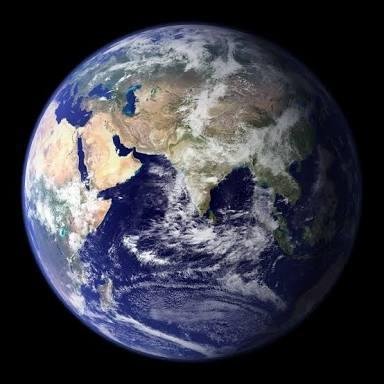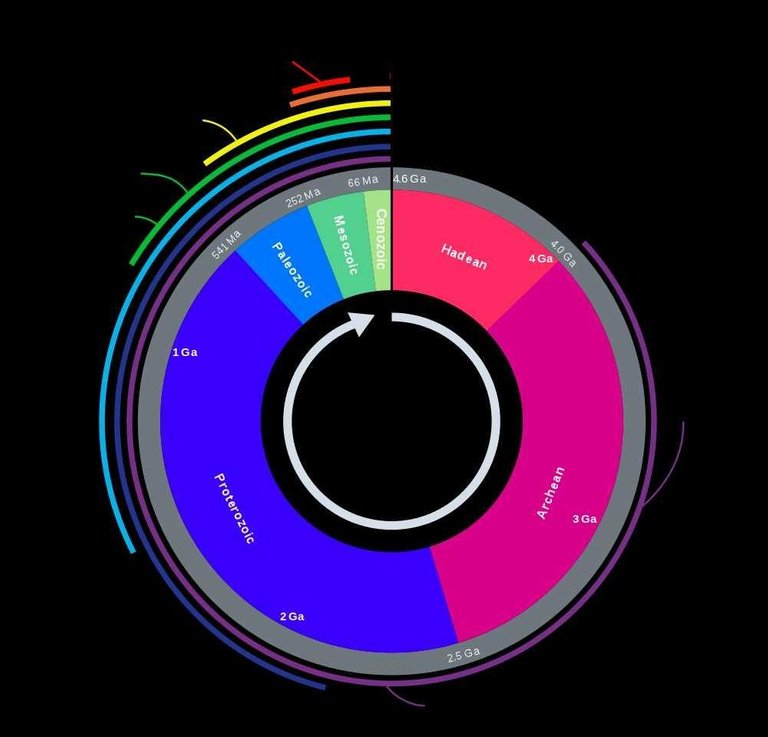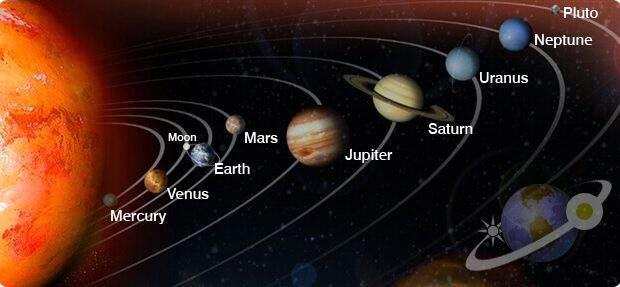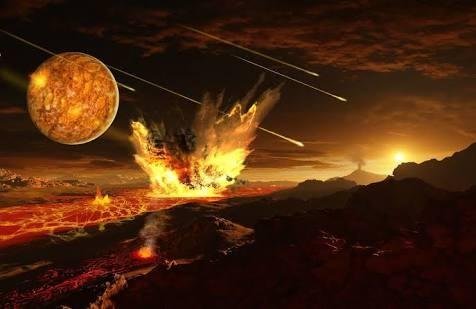
The history of Earth concerns the development of planet Earth from its formation to the present day. Nearly all branches of natural science have contributed to the understanding of the main events of Earth's past. The age of the Earth is approximately one-third of the age of the universe. An immense amount of geological change has occurred in that timespan, accompanied by the emergence of life and its subsequent evolution.
Earth formed around 4.54 billion years ago by accretion from the solar nebula.Volcanic outgassing probably created the primordial atmosphere and then the ocean; but the atmosphere contained almost no oxygen and so would have been toxic to most modern life including humans. Much of the Earth was molten because of frequent collisions with other bodies which led to extreme volcanism. A giant impact collision with a planet-sized body named Theia while Earth was in its earliest stage, also known as Early Earth, is thought to have been responsible for forming the Moon. Over time, the Earth cooled, causing the formation of a solid crust, and allowing liquid water to exist on the surface.

The geological time scale (GTS) clock (see graphic) depicts the larger spans of time from the beginning of the Earth as well as a chronology of some definitive events of Earth history. The Hadean Eon represents time before the reliable (fossil) record of life beginning on Earth; it began with the formation of the planet and ended at 4.0 billion years ago as defined by international convention.The Archean and Proterozoic eons follow; they produced the abiogenesis of life on Earth and then the evolution of early life. The succeeding eon is the Phanerozoic, which is represented by its three component eras: the Palaeozoic; the Mesozoic, which spanned the rise, reign, and climactic extinction of the huge dinosaurs; and the Cenozoic, which presented the subsequent development of dominant mammals on Earth.
Hominins, the earliest direct ancestors of the human clade, rose sometime during the latter part of the Miocene epoch; the precise time marking the first hominins is broadly debated over a current range of 13 to 4 million years ago. The succeeding Quaternary period is the time of recognizable humans, i.e., the genus Homo, but that period's two million-year-plus term of the recent times is too small to be visible at the scale of the GTS graphic. (Notes re the graphic: Ga means "billion years"; Ma, "million years".)
The earliest undisputed evidence of life on Earth dates at least from 3.5 billion years ago,during the Eoarchean Era after a geological crust started to solidify following the earlier molten Hadean Eon. There are microbial mat fossils such as stromatolites found in 3.48 billion-year-old sandstone discovered in Western Australia.Other early physical evidence of a biogenic substance is graphite in 3.7 billion-year-old metasedimentary rocks discovered in southwestern Greenland as well as "remains of biotic life" found in 4.1 billion-year-old rocks in Western Australia. According to one of the researchers, "If life arose relatively quickly on Earth … then it could be common in the universe."
Living forms derived from photosynthesis appeared between 3.2 and 2.4 billion years ago and began enriching the atmosphere with oxygen. Life remained mostly small and microscopic until about 580 million years ago, when complex multicellular life arose, developed over time, and culminated in the Cambrian Explosion about 541 million years ago. This event drove a rapid diversification of life forms on Earth that produced most of the major phyla known today; and it marked the end of the Proterozoic Eon and the beginning of the Cambrian Period of the Paleozoic Era. More than 99 percent of all species, amounting to over five billion species,that ever lived on Earth are estimated to be extinct.Estimates on the number of Earth's current species range from 10 million to 14 million,of which about 1.2 million have been documented and over 86 percent have not yet been described.More recently, in May 2016, scientists reported that 1 trillion species are estimated to be on Earth currently with only one-thousandth of one percent described.
Geological change has been a constant of Earth's crust since the time of its formation, and biological change since the first appearance of life. Species continue to evolve, taking on new forms, splitting into daughter species or going extinct in the process of adapting or dying in response to ever-changing physical environments. The process of plate tectonics continues to play a dominant role in the shaping of Earth's oceans and continents and the living species they harbor. Changes in the biosphere—now dominated by human activity—continue, in turn, to produce significant effects on the atmosphere and other systems of the Earth's surface, such as the integrity of the ozone layer, the proliferation of greenhouse gases, the conditions of productive soils and clean air and water, and others.
The creation of a solar system

Astronomers are confident they understand how our solar system formed as they have seen other solar systems go through a similar process. About 50 light years away lies Beta Pictoris, a star at the centre of an infant solar system. Images from the Hubble Space Telescope show a dusty disc around the star, possibly full of budding planetesimals. Meanwhile, computer models of dust clouds, such as the one believed to have given birth to our system, show that the gravitational forces almost always lead to a flat dusty disc of spinning lumps, from which planets can grow.
How Did Water Come to Earth?

Water is so vital to our survival, but strangely enough, we don’t know the first thing about it—literally the first. Where does water, a giver and taker of life on planet Earth, come from? When I was in junior high school, my science teacher taught us about the water cycle—evaporation from oceans and lakes, condensation forming clouds , rain refilling oceans and lakes—and it all made sense. Except for one thing: None of the details explained where the water came from to begin with. I asked, but my teacher looked as if I’d sought the sound of one hand clapping.
To be fair, the origin of our planet’s water is an intricate story stretching back some 13.8 billion years to the Big Bang. And a key part of the story, centering on two particular solar system denizens, has been hotly debated for decades.
Here’s the part we think we understand well: Just shy of a trillionth of a trillionth of a second after the Big Bang, the energy that sparked the outward swelling of space transmuted into a hot, uniform bath of particles. During the next three minutes, these primordial constituents bumped and jostled, combined and recombined, yielding the first atomic nuclei. One of the great triumphs of modern cosmology is its mathematical description of these processes, which gives accurate predictions for the cosmic abundances of the simplest nuclei—a lot of hydrogen, less helium and trace amounts of lithium. Producing copious hydrogen is a propitious start en route to water, but what about the other essential ingredient, oxygen?


That’s where stars, already plentiful about a billion years after the Big Bang, enter the picture. Deep within their blisteringly hot interiors, stars are nuclear furnaces that fuse the Big Bang’s simple nuclei into more complex elements, including carbon, nitrogen and, yes, oxygen. Later in their lives, when stars go supernova, the explosions spew these elements into space. Oxygen and hydrogen commingle to make H2O.
So are we done? Not quite. In fact, this is where things get a little murky. Water molecules were surely part of the dusty swirl that coalesced into the Sun and its planets beginning about nine billion years after the Big Bang. But Earth’s early history, including epochs with high ambient temperatures and no enveloping atmosphere, implies that surface water would have evaporated and drifted back into space. The water we encounter today, it seems, must have been delivered long after Earth formed.
Faced with this conundrum, astronomers realized that there are two ready-made sources: comets and asteroids, the solar system’s gravel strewn among planetary boulders. The primary difference between the two is that comets typically have a greater concentration of ingredients that vaporize when heated, accounting for their iconic gaseous tails. Both comets and asteroids can contain ice. And if, by colliding with Earth, they added the amount of material some scientists suspect, such bodies could easily have delivered oceans’ worth of water. Accordingly, each has been fingered as a suspect in the mystery.
Adjudicating between the two is a challenge, and over the years scientific judgment has swung from one to the other. Nevertheless, recent observations of their chemical makeups are tipping the scale toward asteroids. Researchers reported last year, for example, that the ratios of different forms of hydrogen in asteroids appear to better match what we find here on Earth. But the analyses are based on limited samples, meaning there’s a good chance we’ve not yet heard the final word.
Thank You @sujoy1995
Sources:
https://en.wikipedia.org/wiki/History_of_Earth
https://www.theguardian.com/science/2008/apr/28/starsgalaxiesandplanets.geology
"Understanding Geochronology: Primer & Reference Guide: Primer & Reference Guide"
- Use a few sentences from your source in “quotes.” Use HTML tags or Markdown.
- Linking to your source
- Include your own original thoughts and ideas on what you have shared.
Not indicating that the content you copy/paste is not your original work could be seen as plagiarism.
Some tips to share content and add value:
Repeated plagiarized posts are considered spam. Spam is discouraged by the community, and may result in action from the cheetah bot.
Creative Commons: If you are posting content under a Creative Commons license, please attribute and link according to the specific license. If you are posting content under CC0 or Public Domain please consider noting that at the end of your post.
If you are actually the original author, please do reply to let us know!
Thank You!
it would be better if you had cited sources of article and the images. by the way nice article
Thank yoy
wonderful article . followed
Thank you